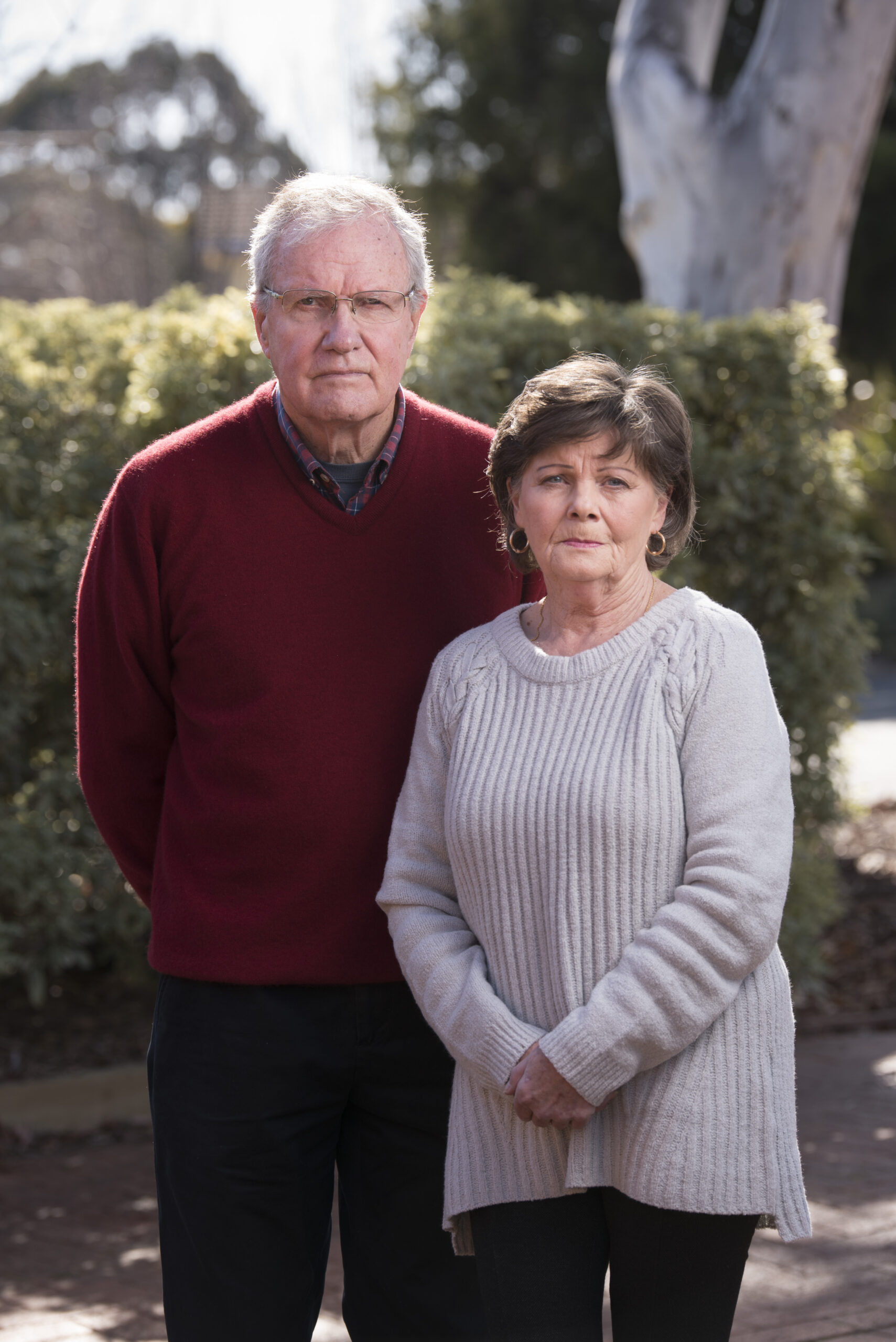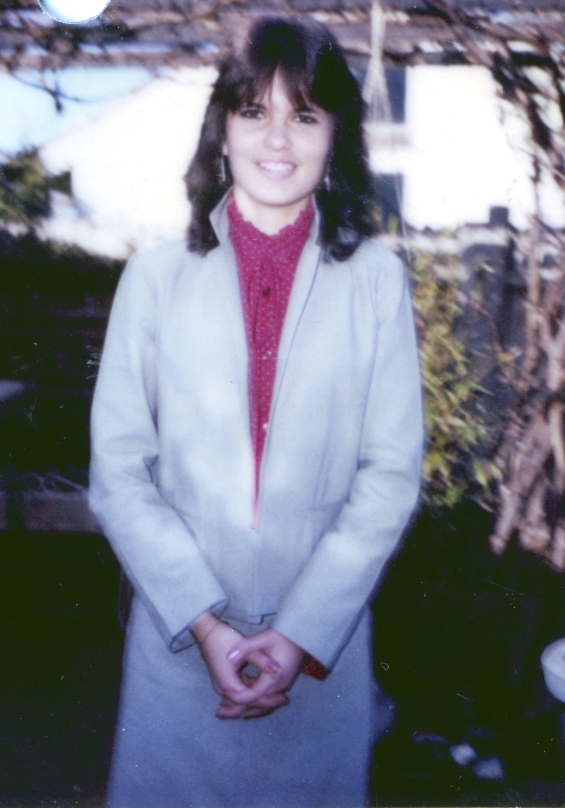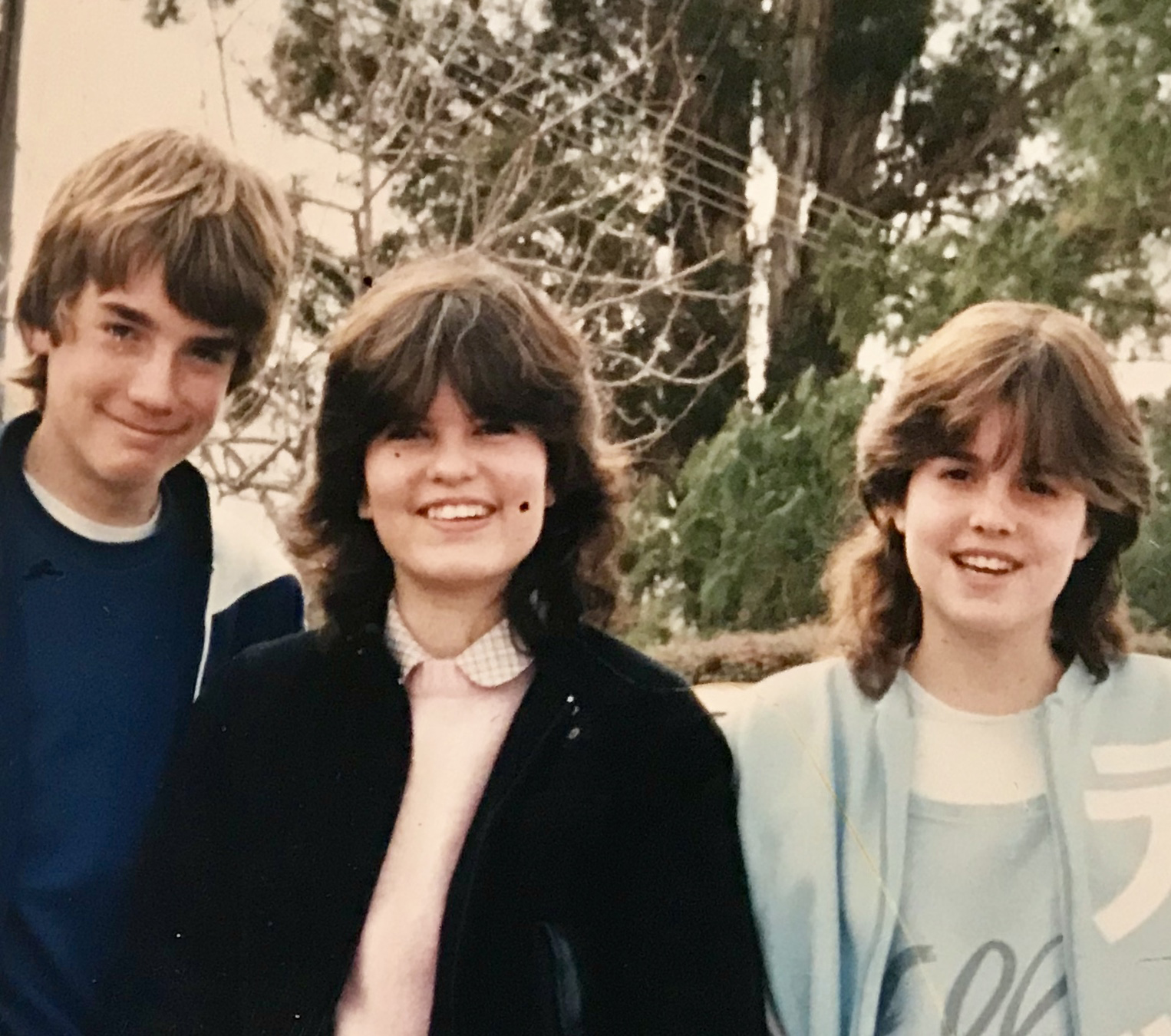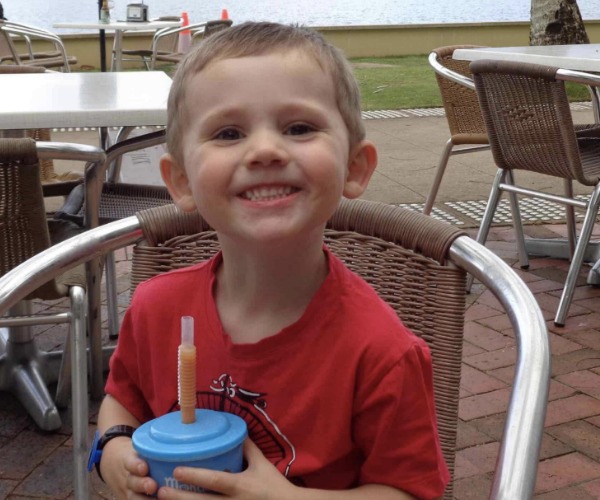In the framed photo on her mother’s wall, Megan Louise Mulquiney looks like a happy, normal 17 year old. She has a warm smile and hazel eyes framed by chestnut hair cut into the type of feathered fringe fashionable in the 1980s.
To this day, it’s how her parents, Dorothy Tallis and Paul Mulquiney, remember her, frozen in time and forever young. Thirty-four years ago, Megan disappeared into Canberra’s thin, cold air and was never seen again. She’d left home for her part-time job early on the wet winter’s day and by the afternoon she was gone. There was no warning, no reason and no trace left behind.
Sitting with Paul and Dorothy in Dorothy’s neat, warm lounge room, it’s easy to imagine their first born. They describe Megan as “gentle, warm, loving and a little bit shy”; a keen ice-skater and a gifted student. “She was a beautiful girl,” Dorothy says, with tears in her eyes. “She was such a good girl. She never did anything to upset you. And then she just disappeared and that’s really, really hard.”
Megan’s disappearance baffled police. She was last seen at the Woden Plaza, a retail centre in Canberra’s south, in an area surrounded almost entirely by wooded nature reserves. Police investigated several people at the time, including an older student from Megan’s school and a violent sex offender who targeted young women at shopping centres, but there wasn’t enough evidence to arrest anyone.
“It’s been a long time,” Paul says. “For the past 34 years we have hoped against hope that we would learn what had happened to Megan. My parents passed not knowing and felt tortured there had been no resolution. Dorothy and I are both in our seventies and our greatest wish is that we will find out who was responsible for Megan’s demise.”
Paul and Dorothy are no longer married but, together with Paul’s wife Liz, remain bound by unspeakable grief. “We were hoping for a bit of closure by now,” says Paul. “The time that’s taken, we’ve had a lot of grief. It just doesn’t go away.”

Paul and Dorothy have suffered for 34 years not knowing what happened to Megan.
For more than 30 years, homicide detectives have been collecting pieces of information, hoping a picture of Megan’s last moments would emerge. The teens who went to school with Megan are now in their fifties, the scene of her last sighting has been renovated and one witness who was named in an inquest into Megan’s probable murder has died. There was no CCTV at Woden Plaza in 1984, and no security footage of any sort that police could scrutinise. All of this has hampered their investigation, but now, new clues have come to light.
We meet four days before the anniversary of Megan’s disappearance, when officers will return to the shopping centre to see if the auspicious date stirs the memory of someone who might help them fill in some of the still missing pieces. “People might not know they know something. They could be sitting on information,” Senior Constable Pat O’Brien of the homicide squad says. “Things that seem unimportant, or people might not consider important, might fit into a picture for us. We reckon there are people out there who would know.”
They’re also hoping the passage of time might have given people the courage to come forward and help them deliver justice for Megan, and for her loved ones, peace.
The last time Dorothy saw the eldest of her three children on the morning of Saturday, July 28, 1984, Megan seemed happy and normal. “Nothing was wrong,” Dorothy says.
Megan caught the bus to Woden Plaza to work an 8.30 shift at Big W and was seen leaving her workplace around noon. The last known sighting places her outside the western entrance of the plaza next to the western car park around 12.15. She was supposed to catch a bus home, but as we now know, she didn’t.
It didn’t take long for Dorothy to start to worry. Megan was reliable. It was not like her to be late. “By one o’clock I pressed the panic button,” Dorothy says. “I knew there was something wrong because it was totally out of character. I rang a few of her friends. Nobody knew anything or had seen her.”

Megan disappearing was totally out of character. Image supplied and used with permission.
“I too immediately had a sinking feeling that something terrible had happened to Megan,” Paul adds. “Each time I rang Dorothy that afternoon and evening there was nothing positive to report. As I tried to sleep that night, all I could visualise was that Megan was in a terrible place. I felt that my darling first-born daughter was gone from us.”
Even now, Dorothy finds it difficult to talk about the nightmarish hours, days and weeks after Megan disappeared. She shakes her head, tears in her eyes, when asked if she can describe what it was like.
A detective working on the case told The Canberra Times in August 1984 that they had no firm leads. “A person who knew her saw her apparently waiting for someone at the Bryant’s pie shop exit of the shopping square,” Detective Sergeant Geoff Lanham told The Times.
One possible line of inquiry was this “someone” Megan may have been waiting for. Police learned that gentle Megan had caught the eye of an older boy at Narrabundah College. Phillip T was a Year 12 student who had asked Megan to go out with him. After she said no, he pursued her for a year until she gave in and agreed to have lunch. According to evidence presented at an inquest, she was due to meet Phillip after her shift at the Woden Plaza the day she disappeared.
Phillip is one of the many people police questioned at the time. He told them that, yes, there had been a plan to meet but he couldn’t find Megan when he arrived at the plaza, so he went home. Over the course of numerous conversations with investigators he provided a “fairly consistent” account of what had happened, and his version of events was corroborated by other people who had seen him throughout the day. Pretty quickly, police were satisfied that he was not a suspect.
The Woden Plaza has been made over into a slick and shiny new Westfield, but in the mid-1980s it had a reputation for being quite rough. Police combed the surrounding areas, neighbouring nature reserves and the Brindabella Range in the national park east of the capital. Divers scoured Lake Burley Griffin, the large body of water in the heart of Canberra, and Lake Ginninderra, 15km north of the shopping centre. Not so much as a hair was found.
“How does it happen?” Dorothy asks.
Then came another shock. Two months after Megan disappeared, another 17-year-old girl was snatched from the very same car park and sexually assaulted in a pine forest.
On Friday, September 21, 1984, a man named Paul Vincent Phillips, then 24, forced his way into the young woman’s car in the western car park of the Woden Plaza and drove her to the Uriarra Pine Forrest where he raped her at knifepoint. He was arrested the following day and later sentenced to seven years in prison after pleading guilty to abduction, robbery, assault and rape.
Paul Vincent Phillips went on to become a serial violent sex offender. The 17-year-old teen he snatched from Woden in September 1984 was the first known victim in a series of young women who all matched a particular profile. They would often appear young, have child-like features, petite builds, with their shoulder-length hair worn loose.
“This description matches that of Megan,” Detective Senior Constable Emma Beere, who is currently investigating the case, said recently.
Paul Vincent Phillips has also been linked to a series of horrific, unsolved sex attacks in Canberra in the early 1980s. But he was called to give evidence before an inquest into Megan’s disappearance in 2009 and denied any involvement. The Canberra Times reported that, when asked what it would take for him to admit what he had done to Megan, he said: “It would take for me to have done it. I swear that on my children. I have children of my own.”
Other theories emerged. There was speculation that Megan had run away with a boyfriend and did not want to be found, but her family rejected this. “Absolutely not,” Dorothy says.
As the months rolled past, the family waited. Police were knocking on doors and trying to find answers, but there were no solid leads. In 1985, the local church got in touch with Dorothy and recommended the family hold a memorial service. “I respect the church for having done it,” Dorothy says. “But it didn’t help. Doesn’t help.”

Dorothy just wants to know what happened to her precious daughter.
The word of a prince
Then, in 2004, new information emerged from an unexpected source. An Irish woman named Niamh Large contacted the police in Ireland about a Buddhist teacher, named Prince Ratu, who had tutored her at a Buddhist society based in Melbourne. Niamh said Prince Ratu had spoken about a man with “huge karma to pay” because he had murdered someone when he was younger. Prince Ratu said the man had hit his victim over the head with a baseball bat and disposed of her body in a dumpster. The alleged killer of the story was identified as Phillip T.
Victorian police interviewed Phillip, who again denied murdering Megan. He said that he did have counselling sessions with Prince Ratu, and he did speak about Megan but the guilt Prince Ratu referred to must have been the sense of remorse Phillip felt for failing to meet her. Investigating officers later told the 2009 coronial inquest into Megan’s case that they did not think Phillip, now in his fifties, was involved in Megan’s disappearance. Prince Ratu died before he could be interviewed. The Australian Women’s Weekly does not suggest Phillip had anything to do with Megan’s death.
At the conclusion of the inquest in 2011, Coroner Peter Dingwall said it was most likely Megan was murdered but there was still not enough evidence to refer any particular person to the director of public prosecutions. However, he noted, there was a very strong circumstantial case to be made against Paul Vincent Phillips who, almost immediately after being released from prison for the attack on the 17-year-old girl at Woden Plaza, was arrested in Tasmania for the attempted abduction of another young woman, also at a suburban shopping centre.
In 2007, police received an anonymous tip that Paul Vincent Phillips had dumped Megan’s remains near the Woods Reserve, in Tharwa, outside of Canberra, but they didn’t find anything when they searched the area. Coroner Dingwall ultimately listed the cause of her death as unknown, and said it was a tragic loss.
“Megan was a very stable and reliable girl … she did not drink or have boyfriends and her social life consisted mainly of ice-skating with her younger sister,” Coroner Dingwall said.

Megan was a 17-year-old teen when she disappeared. Image supplied and used with permission.
The inquest offered little by the way of comfort to Megan’s family. In fact, it had the opposite effect. For years, Dorothy had been visiting the church memorial with flowers for Megan.
“After the inquest, actually, that changed a lot for me,” she says. “I knew she didn’t run away. But that sealed it for me. I knew we weren’t going to see her again.”
A break in the case
The trail seemed to go cold. Megan’s family felt hopeless. In his inquest findings, Coroner Dingwall said, “Any hope of solving the mystery of her disappearance now rests largely upon members of the public coming forward.”
Seven years passed. Then, in April this year, Paul Vincent Phillips died. He had spent the majority of his adult life behind bars for numerous violent sexual offences against young women and had been placed on the sex offenders register. After his death, police once again started receiving information about that cold, dark day in 1984.
Days before returning to Woden for the anniversary of Megan’s disappearance, they held an extraordinary press conference to announce they now believe Paul Vincent Phillips, the primary suspect in Megan’s disappearance, didn’t act alone.
“The investigation into Megan’s disappearance didn’t die with Paul Phillips,” Senior Constable Beere explained. “We know there are people who are aware of the circumstances surrounding Megan’s disappearance and we’re appealing to these people to have the courage to come forward and speak to police.”
After all this time, Dorothy and Paul’s hope is that someone decides to act.
“It won’t be nice. I totally accept that,” Dorothy says. “But just to be able to put her to rest, heal your brain and your heart a little bit, too …” she trails off, tearful. “I don’t want revenge. I just want to know where her remains are. The only thing I really want in the world now is to know what happened to Megan. I need to know.”


